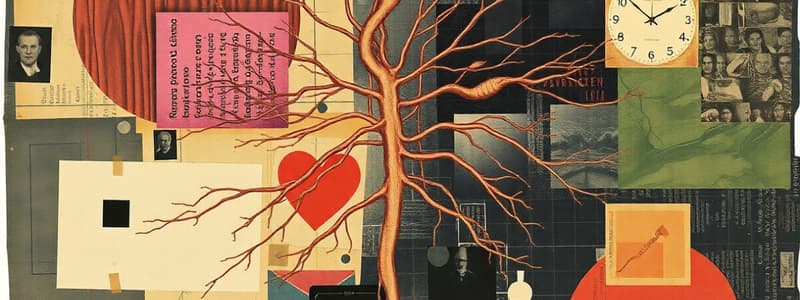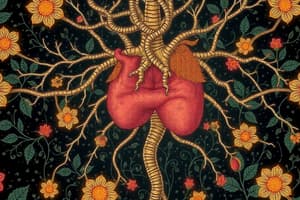Podcast
Questions and Answers
What type of receptors are activated by norepinephrine in the sympathetic system?
What type of receptors are activated by norepinephrine in the sympathetic system?
- Dopaminergic receptors
- Muscarinic receptors
- Alpha and beta adrenergic receptors (correct)
- Nicotinic receptors
Which of the following neurons release acetylcholine?
Which of the following neurons release acetylcholine?
- Only the preganglionic neurons of the sympathetic system
- All parasympathetic post-ganglionic neurons (correct)
- Only neurons in the thoracic region
- All sympathetic post-ganglionic neurons
Which division of the autonomic nervous system is associated with the thoraco-lumbar origin?
Which division of the autonomic nervous system is associated with the thoraco-lumbar origin?
- Sympathetic division (correct)
- Enteric nervous system
- Somatic nervous system
- Parasympathetic division
What type of receptors are found in all organs innervated by the parasympathetic system?
What type of receptors are found in all organs innervated by the parasympathetic system?
Which neurotransmitter is released by sweat gland innervation in the sympathetic system?
Which neurotransmitter is released by sweat gland innervation in the sympathetic system?
Which neurotransmitter is primarily associated with nicotinic receptors?
Which neurotransmitter is primarily associated with nicotinic receptors?
Which of the following is NOT a site of release for norepinephrine?
Which of the following is NOT a site of release for norepinephrine?
What distinguishes the fiber types of the sympathetic postganglionic neurons?
What distinguishes the fiber types of the sympathetic postganglionic neurons?
Which type of autonomic ganglia is primarily a relay site for preganglionic sympathetic fibers only?
Which type of autonomic ganglia is primarily a relay site for preganglionic sympathetic fibers only?
What is the main site of relay for preganglionic sympathetic and parasympathetic fibers?
What is the main site of relay for preganglionic sympathetic and parasympathetic fibers?
What characterizes terminal ganglia?
What characterizes terminal ganglia?
What are the principal neurotransmitters involved in chemical transmission at autonomic junctions?
What are the principal neurotransmitters involved in chemical transmission at autonomic junctions?
Which of the following describes a function of autonomic ganglia?
Which of the following describes a function of autonomic ganglia?
In which location are collateral ganglia primarily found?
In which location are collateral ganglia primarily found?
What type of fibers do terminal ganglia relay?
What type of fibers do terminal ganglia relay?
Which statement is true regarding the location and function of lateral ganglia (paravertebral)?
Which statement is true regarding the location and function of lateral ganglia (paravertebral)?
Flashcards
What are autonomic ganglia?
What are autonomic ganglia?
A collection of nerve cells located outside the central nervous system (CNS) that contain the nerve cells of the postganglionic neurons.
What are lateral ganglia?
What are lateral ganglia?
They are located on both sides of the vertebral column and serve as relay points for preganglionic sympathetic fibers.
What are collateral ganglia?
What are collateral ganglia?
They are found in the abdomen near the major branches of the aorta and mainly relay preganglionic sympathetic fibers.
What are terminal ganglia?
What are terminal ganglia?
Signup and view all the flashcards
What's one function of autonomic ganglia?
What's one function of autonomic ganglia?
Signup and view all the flashcards
What's another function of autonomic ganglia?
What's another function of autonomic ganglia?
Signup and view all the flashcards
What's yet another function of autonomic ganglia?
What's yet another function of autonomic ganglia?
Signup and view all the flashcards
How do autonomic junctions communicate?
How do autonomic junctions communicate?
Signup and view all the flashcards
Acetylcholine's role in the ANS
Acetylcholine's role in the ANS
Signup and view all the flashcards
Noradrenaline's role in the ANS
Noradrenaline's role in the ANS
Signup and view all the flashcards
What are adrenergic receptors?
What are adrenergic receptors?
Signup and view all the flashcards
Types of adrenergic receptors
Types of adrenergic receptors
Signup and view all the flashcards
What are muscarinic receptors?
What are muscarinic receptors?
Signup and view all the flashcards
What are nicotinic receptors?
What are nicotinic receptors?
Signup and view all the flashcards
What activates cholinergic receptors?
What activates cholinergic receptors?
Signup and view all the flashcards
Origin of Sympathetic System
Origin of Sympathetic System
Signup and view all the flashcards
Study Notes
Autonomic Nervous System
- The autonomic nervous system (ANS) is responsible for involuntary functions
- It regulates organs and glands without conscious effort
- It's composed of two main divisions: sympathetic and parasympathetic
- The two divisions have opposite effects on target organs
- The sympathetic system is associated with "fight or flight" responses
- The parasympathetic system is associated with "rest and digest" responses
- Neurotransmitters are chemical messengers that transmit signals across synapses.
Autonomic Ganglia
- They are collections of nerve cells outside the central nervous system (CNS)
- Ganglia contain post-ganglionic neurons
- Ganglia act like relay stations
- Types of ganglia include lateral, collateral, and terminal
Lateral Ganglia
- Form part of the sympathetic chain
- Located on either side of the vertebral column
- Sites for relay of preganglionic sympathetic fibers
Collateral Ganglia
- Located in the abdomen near major arteries (aorta)
- Relay station for preganglionic sympathetic and some parasympathetic fibers
Terminal Ganglia
- Located near or on the wall of effector organs
- Relay station for preganglionic parasympathetic fibers
Functions of Autonomic Ganglia
- Relay stations for preganglionic nerves, providing signal transmission to postganglionic nerves
- Distributing centers for autonomic nerves
- Sites where drugs may act
Chemical Divisions of the ANS
- The ANS is separated into cholinergic and noradrenergic systems based on neurotransmitters
- Cholinergic system uses acetylcholine (ACh)
- Noradrenergic system releases noradrenaline (norepinephrine)
Acetylcholine (ACh)
- Principal neurotransmitter for all preganglionic fibers within the ANS
- Released by all preganglionic parasympathetic neurons
- Release by sympathetic post-ganglionic neurons innervating sweat glands and skeletal muscles
Norepinephrine (Nor-adrenaline)
- Main sympathetic post-ganglionic neurotransmitter (except for sweat glands and blood vessels)
- Released by most sympathetic post-ganglionic neurons
Adrenergic Receptors
- Types include alpha (α) and beta (β)
- Located in organs and tissues innervated by sympathetic post-ganglionic fibers
- Activated by noradrenaline
Cholinergic Receptors
- Includes muscarinic (M) and nicotinic (N) subtypes
- Muscarinic receptors are found on effector cells in parasympathetic responses
- Nicotinic receptors are present in autonomic ganglia
Origins and Types of Fibers
- Sympathetic fibers originate from thoracic and lumbar regions of the spinal cord
- Parasympathetic fibers originate from cranial and sacral segments
- Sympathetic fibers are typically short preganglionic and long postganglionic fibers
- Parasympathetic fibers are typically long preganglionic and short postganglionic fibers.
Studying That Suits You
Use AI to generate personalized quizzes and flashcards to suit your learning preferences.




